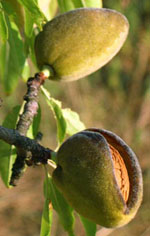All About Almonds
[ad] Empty ad slot (#1)!
Description
The almond tree is a tree that grows from four to ten meters high. The trunk of this small deciduous tree can grow to be 30 centimeters wide. It takes an almond tree three to five years to grow almonds. The leaves on the trees grow from three to five inches long. About seven months after the almond tree’s flowers bloom, almonds begin to grow. The almond is not a nut, but a drupe, a fruit with an outer skin that covers the shell and seed on the inside. The outer skin is fleshy and green. Inside that is a woody shell with the almond inside it. The almond grows from about three to five centimeters long between the months of April and June. About 1.7 million tons of almonds are grown worldwide.
Types of Almonds
There are two types of almonds. There are the sweet almonds that are white with a brown skin. These are the almonds we buy from the grocery store and eat with other nuts. There are also bitter almonds. Bitter almonds are shorter and wider than the sweet almonds. To know which kind of almonds your almond tree is growing, look at the flowers. White flowers usually produce sweet almonds and pink flowers usually produce bitter almonds.
The History of Almonds
The almond tree first grew in North Africa, the Mediterranean and the Middle East. It is a very popular nut in the Middle East. As time passed, this fruit tree would be taken to different parts of the world. Like many other plants and resources, the almond tree spread to Greece, Europe and across the ocean to the United States. It is mostly grown and cultivated in California. The Romans called the almond “Greek nuts” because they were first cultivated in Greece. Amygdalus is the Latin term for amande, and amande is the French term for almond.
Pollination
 Since the almond tree produces flowers before the almond begins to grow on it, bees are attracted to the flowers. California hosts the largest pollination event in the world. Beekeepers and pollination workers are responsible for the bees, beehives and almond trees. The Agricultural Research Service has created some self-pollinating almond trees. Honey bees are great pollinators for almond flowers. Some people rent honeybees to pollinate the almond tree because almond trees are not self-pollinating. They require some help from the bees.
Since the almond tree produces flowers before the almond begins to grow on it, bees are attracted to the flowers. California hosts the largest pollination event in the world. Beekeepers and pollination workers are responsible for the bees, beehives and almond trees. The Agricultural Research Service has created some self-pollinating almond trees. Honey bees are great pollinators for almond flowers. Some people rent honeybees to pollinate the almond tree because almond trees are not self-pollinating. They require some help from the bees.
Benefits of Almonds
The almond may be considered a fruit, but it is one of the healthiest nuts around. About 30 grams of almonds has 184 calories and 16.8 grams of fat. This may seem like a lot of fat, but the fat in almonds is considered to be healthy fat, or monounsaturated fat. The same serving provides 9% of the daily calcium intake and 29% of the daily magnesium intake. They are also good sources of zinc, Vitamin E, potassium, phosphorous, iron, Vitamin C, folate, Vitamin B6, niacin, riboflavin, fiber and protein. They also help to lower cholesterol, heart disease and the risk of cancer. The flavonoids in almonds are very beneficial to the body. An almond may contain a high amount of carbohydrates, but this allows for almond flour to be made.
Culinary Uses of Almonds
Almonds come in many forms. Almond oil, flour, butter, syrup, paste and milk are products found in the market worldwide. Almonds can be found whole, cut or flaked over and in desserts. Different countries use the almond based on their personal cooking dishes. Almond oil can be used as a lotion and by massage therapists during massages. Almond milk is healthy because it has no cholesterol, and almond butter is considered to be a safer fat.
[ad] Empty ad slot (#1)!
Almonds are used to eat as a snack with other nuts raw or toasted. Some people take a couple of almonds around with them where they go. When some people are hungry, they grab a few almonds to keep them busy and full. The oils from almonds are healthy and should be eaten often, if they are not allergic of course. Some people eat the almonds with its fleshy skin as is. It may be sour, but when dipped in salt, many Middle Eastern people eat it this way.

hello
please if possible send for me counteries of importer of almond.
best regards
Almond Oil Edible Grade
Required in Bulk